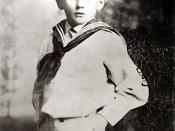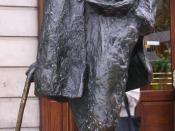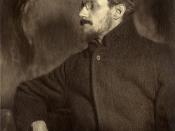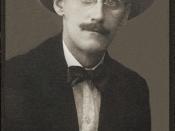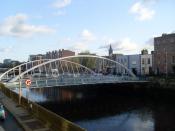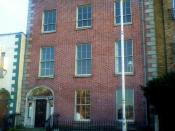English 1B
October 9, 2008
A Sparkle of Darkness
In James Joyce's short story, "Araby", Joyce's choice of imagery throughout this particular story is especially intriguing. Two of the most common found within this narrative, was the imagery of light and vision and how they are commonly used to express the emotions of the main character of the story, a young boy, and his infatuation with his first love. Along with the fabulous pleasantness that a first love may bring to someone, the imagery of light and darkness conveys through this short story that first loves also may bring a sense of anger and frustration that comes with the package of having a first love. Darkness is frequently used to describe the tone of the young boy's surroundings and how it is most often empty and sorrow. Light, also playing the role of imagery of light itself, Joyce time and again uses light to signify it as optimism for the boy and the boy's fascination with his first love.
Finally there is the imagery of vision, which is also an important symbolism that is used often in order to describe the sometimes emotional tension that the boy had when thinking about Magan's sister, whom on which he fell in love with. The symbolism of light and vision in the story, "Araby", light plays the role of expressing the young boy's empty emotions through darkness; and the imagery of light and vision as an image of hope possibly future expectations.
When the imagery of vision comes into play within the story, vision is used when the boy describes his street. At the beginning of the story, he described his dead end street as being "blind", indicating that it even though his street on which he lived on, did have an end, he also seen himself with a dead end to his life because he viewed his life without purpose or meaning.
When Joyce uses the frequent strand of the imagery, darkness, throughout the story, he is basically symbolizing the different perceptions of meaninglessness and distress through the perceptive of the young boy. Darkness is used to describe a number of items throughout the story; however, it is also used commonly when the boy is describing his own street and neighborhood, which signifies that he indeed feels that he is alone.
Take for instance the example that the boy uses the word "blind" as a way of describing the street on which he lives, Richmond Street. The manner that he chooses his words for portraying an image of his own street was to illustrate the reader that the surrounding area of this boy's neighborhood to be filled with emptiness and despair (p. 91).
Another example to which the expression "dark" is used numerous instances in order to describe a place, which happens to also be close to where the boy is living, the surrounding area to the boy's street. "brought us through the dark muddy lanes behind the houses where we ran the gauntlet of the rough tribes from the cottages, to the back doors of the dark dripping gardens where odours arose from the ashpits, to the dark odorous stablesâ¦" (p. 91). As the boy is carefully describing his normal play time with his friend, the imagery of darkness of this short passage suggests that the town is filled with shadowy and indistinct dark secrets in the streets and houses.
Although darkness is portrayed several times throughout this story, however light is also a major form of imagery that is also delivered from time to time signifying significance as well. When the imagery of light comes into play within this story, light not only reveals a sign of positive energy that the boy has, but it also offers the boy a sense of hope. It is as if the image of light mentioned throughout the story most often seems to be out of the darkness and onto the older girl, Magan's sister, which he is overwhelmingly mesmerized by.
Because of the boy's infatuation with Magan's sister, he eventually turns all his darkness into light which is hope for the boy. The sister is a sign of hope and because of her, the boy not only finds something to brighten up his loneliness that surrounds him, but it also gives him that boost of hope and meaning to his life. The sister has become a light, almost a sparkle, in the young boy's life, a reflection of that sparkle that he takes with him to "places the most hostile to romance" (p.92). Because of the young boy's infatuation with Magan's sister, her image is always in the back of his mind, taking her with him where ever he may go.
Take for instance the example in the story where the boy see's Magan's sister as a light: the "light from the lamp opposite our door caught the white curve of her neck, lit up her hair that rested there and, falling, lit up the hand upon the railing. It fell over on side of her dress and caught the white border of a petticoatâ¦visible as stood at ease" (p. 92). The representation of the girl wearing the white dress indicates wholesomeness and goodness, which the boy so desperately needs at this point in his life.
When it comes to realizing what significance of each of the imagery that is used throughout the story, "Araby", one thing is for sure: the imagery that James Joyce portrays it in a way that it anyone can relate to due to the fact that the boy in the story is someone we all have been in a point in our lives. The description of darkness and the imagery of light and vision all come into play and almost work together to get that sense of tone of the overall story that Joyce wanted to portray. The blindness of vision, the loneliness of dark, and that oh so greatness of sparkle that is the light, all of which are significant to the boy when he falls for his first love, and all the darkness and sparkle that is to come along with it.
